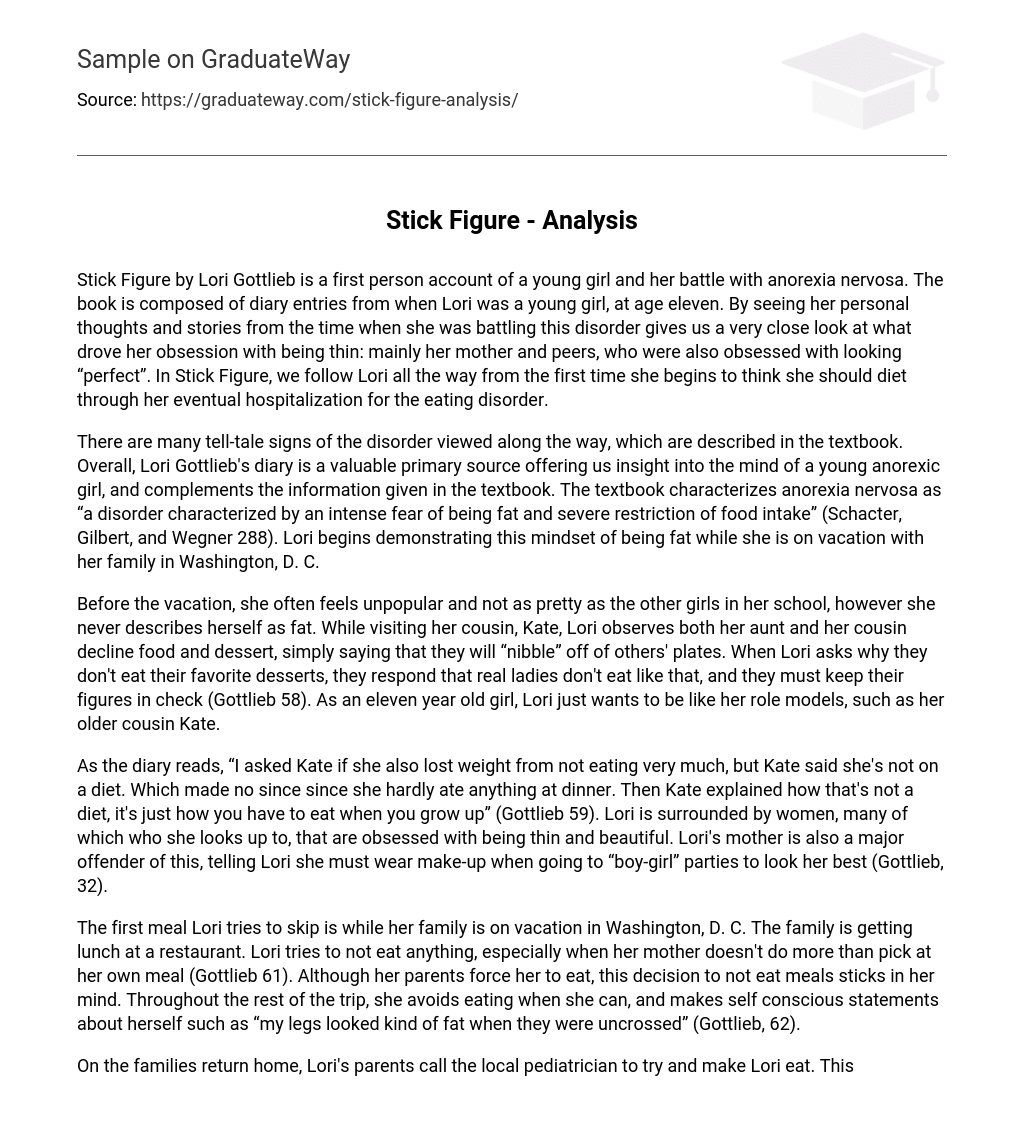“Stick Figure” by Lori Gottlieb provides a first-person perspective on a young girl’s struggle with anorexia nervosa. The book consists of diary entries written when Lori was only eleven years old. Through these personal accounts, we gain insight into the factors that fueled her obsession with being thin, particularly her mother and peers who shared the same preoccupation with attaining perfection. The narrative takes us on Lori’s journey from her initial contemplation of dieting to her eventual hospitalization for the eating disorder.
The textbook details various signs of the disorder that are observed throughout. Overall, Lori Gottlieb’s diary offers valuable firsthand proof that sheds light on the thoughts of a young girl struggling with anorexia, and it supplements the information presented in the textbook. The textbook defines anorexia nervosa as “a disorder characterized by an intense fear of being fat and severe restriction of food intake” (Schacter, Gilbert, and Wegner 288). While on her family vacation in Washington, D.C., Lori begins to display this belief of being overweight.
Before going on vacation, she often feels unpopular and less attractive than the other girls in her school, but she never considers herself overweight. While staying with her cousin Kate, Lori notices that both her aunt and cousin resist eating food and dessert, opting to only “nibble” from others’ plates. When Lori questions their decision to not indulge in their favorite treats, they explain that proper ladies do not eat in that manner and must maintain their body shape (Gottlieb 58). As an 11-year-old girl, Lori simply desires to be like her role models, including her older cousin Kate.
According to the diary entry, Kate denies being on a diet despite not eating much during dinner. Lori finds it contradictory, especially since she herself eats very little. Kate explains that it is not a diet but how one needs to eat when growing up (Gottlieb 59). Lori is constantly surrounded by women whom she idolizes, and most of them are fixated on being thin and attractive. Her own mother contributes to this obsession by insisting that Lori wears makeup to look her best at “boy-girl” parties (Gottlieb, 32).
Lori attempts to skip her first meal while her family is on vacation in Washington, D. C. They are at a restaurant for lunch, and Lori resists eating anything, especially since her mother only picks at her own meal (Gottlieb 61). Although her parents insist that she eat, the memory of this decision to not eat meals lingers in Lori’s mind. For the rest of the trip, she avoids eating whenever possible and makes self-conscious comments about herself like “my legs looked kind of fat when they were uncrossed” (Gottlieb, 62).
Upon returning home, Lori’s parents reach out to the local pediatrician in hopes of persuading her to eat. However, this backfires and only fuels her desire to be thinner, leading her doctors to decide on hospital admission. Even while in the hospital, Lori manages to avoid meals by tricking the nurses responsible for ensuring she consumes at least 75% of her food. She confesses that when asked about it, she lied about how much 75% was because “[the nurse] was too tired to think” (Gottlieb 155). Consequently, Elizabeth documented that she ate slightly less than 75% of her breakfast. It is only when faced with the prospect of “The Tube” that Lori finally starts eating. It is not until her mother displays some understanding that Lori realizes just how thin she has become. As her mother remarks while helping her put on a loose-fitting dress, “You look like a stick figure in that dress” (Gottlieb 207). The moment Lori sees herself in the mirror wearing the requested dress is when she fully grasps the severity of being underweight.
She had an epiphany when she realized she resembled the anorexic girls depicted in the photographs shown by psychiatrist Dr. Katz. “Upon entering the bathroom, a thin girl, bearing a striking resemblance to those images in Dr. Katz’s book, caught my eye. The ladies’ restroom was adorned with an abundance of mirrors, which resulted in constant encounters with the emaciated figure. It was as if she was a mere stick figure… I was taken aback. I felt repulsive,” wrote Lori Gottlieb (208). This moment marked a pivotal shift in her eating disorder.
The passage discusses the experience of Lori with anorexia nervosa at the young age of eleven. It is surprising that body consciousness can occur at such a young age. According to the textbook, 40% of anorexia cases are found in females aged 15 to 19 (Schacter, Gilbert, and Wegner 288). It is interesting to note that Lori was not heavily influenced by media, which is commonly believed to be a major cause of eating disorders. However, the pressure from influential women in her life, such as Kate and her mother, greatly contributed to her low self-esteem. Individuals with anorexia often have a distorted body image, perceiving themselves as fat even when they are actually emaciated (Schacter, Gilbert, and Wegner 288). Lori’s diary confirms this distorted body image by documenting her struggle with an eating disorder throughout the year when she was eleven. Lori Gottlieb’s book Stick Figure provides valuable insights into the private thoughts of a young girl battling anorexia nervosa and offers examples to supplement the information presented in the textbook.
Works Cited
The book “Stick Figure: A Diary of My Former Self” by Lori Gottlieb was published in 2000 by Simon and Schuster. It is available in print format.
Another book, “Introducing Psychology” by Daniel Schacter, Daniel Gilbert, and Daniel Wegner was published in 2011 by Worth Publishers. This book is also available in print format and has 288 pages.





